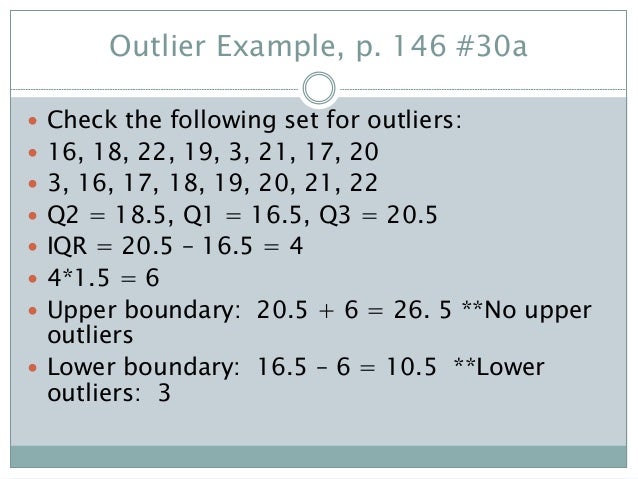
These are publicly available and can also usually be found at your school.Ī. These questions are taken from official previous specimen papers from the IBO. To start, let’s look at some example problems and solutions for paper 1.
#Outlier math calculator how to
The IB rubric or mark scheme tells you how to solve problems in the most efficient way possible, which is usually the way in which IB will give working marks for. Then, solve as many past papers as you can while referring to the rubric of each paper respectively. The best way to prepare for both papers is to collect previous examinations, or past papers. Since the two tests have different styling, the kind of student you are with your strengths and weaknesses determine which exam you’ll excel in. This is because the questions are designed such that a calculator wouldn’t be of much use anyway in solving them. The two exams cover most of the coursework for the class, but since paper 1 is not to be taken with a calculator, you’ll find the formatting and styling of the questions in this paper to differ from paper 2. Paper 1 – 90 marks / 90 minutes long / No calculator permitted.The IB Math SL examination consists of two individual papers, each designed to test the student on different applications of the coursework taught during the two-year course. Please refer to CollegeVine’s ultimate guide to IB for more information! The following blog post is about the International Baccalaureate Diploma Programme (IB / IBDP), and its associated examinations. How Does the IB Math SL Exam Affect My College Chances?.How would you interprete that and would you approve that my t-test and ANOVA would make sense considering that the p-value is very close to 0.IB Guides IB Math SL Exam Practice Questions What’s Covered: The problem is that when I run Shapiro-Wilk Test, one of the series(out of 4) is not recognized as normal with the p-value of 0.04987 It is also confirmed by ‘Outliers and missing data’ in the RealStatistics test results. The Plot box shows no outliers and Grubbs’ Test is insignificant which shows that there is no outlier in the data.
#Outlier math calculator series
After running the test again, the d’Agostino-Pearson test tells me that all 4 series are normal now. It turned out that that record was wrongly measured, so I removed it. I ran the ‘Descriptive Statistics and Normality’ tool and found out that there was a outlier. I have a dataset which consists of 4 series of data, consisting of 4 numeric parameters of 34 samples. sig = “yes” if G > G crit and sig = “no” otherwise.įor Example 1, if you highlight the range P5:Q8, enter the formula =GRUBBS(A4:A14,TRUE) and press Ctrl-Shft-Enter, then the output that appears is displayed in Figure 3.įirst and foremost, would like to thank you for changing my understanding of statistics and providing the RealStatistics tool generously. The potential outlier is either the maximum or minimum value in R1, depending on which is farthest away from the mean of R1. If lab = TRUE (default FALSE) then the output is a 4 × 2 matrix with a column of labels added. GRUBBS(R1, lab, alpha): outputs a 4 × 1 column range with the following entries: potential outlier, G, Gcrit, and test significance Real Statistics Function: The Real Statistics Resource Pack provides the following array function to perform a one-tailed Grubbs’ test. We see that 3 is a little more than 2.5 standard deviations from the mean (cell G6) and that the test is significant (cell G14), meaning that 3 is an outlier (based on α =. However, when we remove the data element 3, which seems to be a potential outlier (as shown in range K4:K14), we find that the data is normally distributed, thus allowing us to use Grubbs’ test Using the Shapiro-Wilk test, we see that the data is not normally distributed.

The data set is shown in range A4:A14 of Figure 1. Alternatively, G can be calculated using the formulaĮxample 1: Determine whether the data set has an outlier.


There is also a two-tailed version of the test where G is the larger of the two G values described above and G crit is defined as above except that the significance level for t crit is α/(2 n). Thus the null hypothesis is rejected if G > G crit. Where t crit is the critical value of the t distribution T( n−2) and the significance level is α/ n. If you suspect that the minimum value in the data set may be an outlier you can use the following test statistic If you suspect that the maximum value in the data set may be an outlier you can use the following test statistic The ESD test should be used instead when there is the possibility of more than one outlier. the alternative hypothesis that there is one outlier. Here we test the null hypothesis that the data has no outliers vs. Grubbs’ test can be used to test the presence of one outlier in a data set that is normally distributed (except possibly for the outlier) and has at least 7 elements (preferably more).


 0 kommentar(er)
0 kommentar(er)
